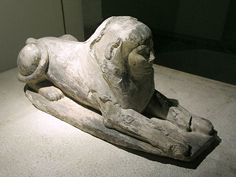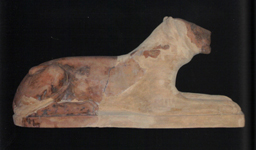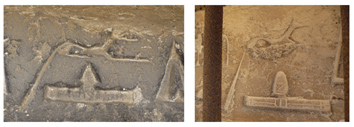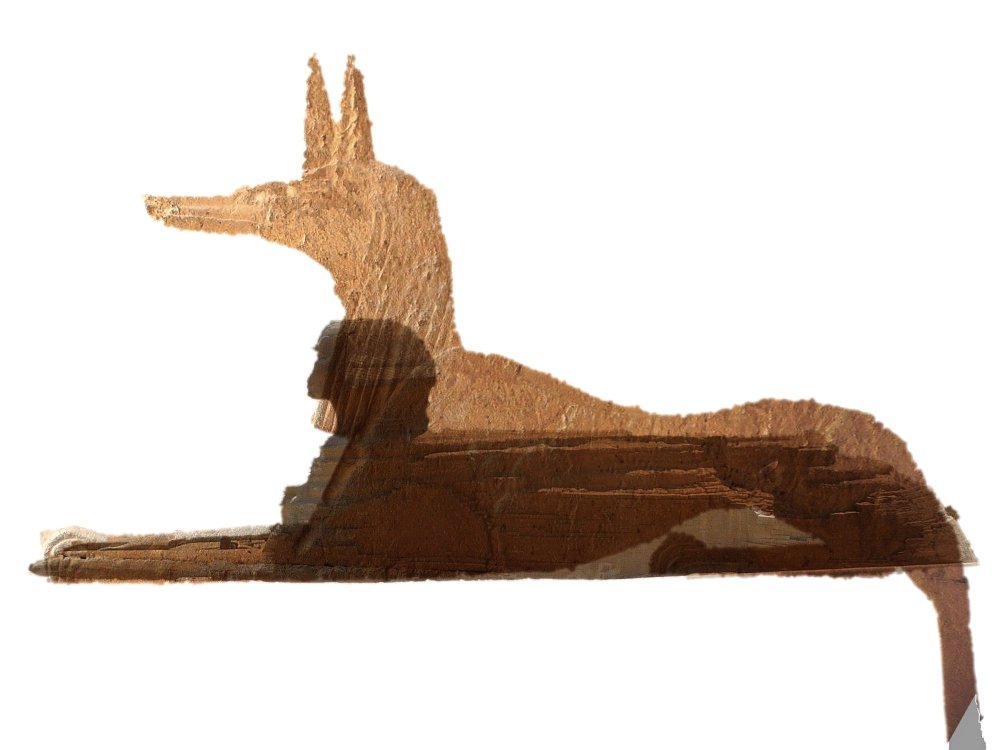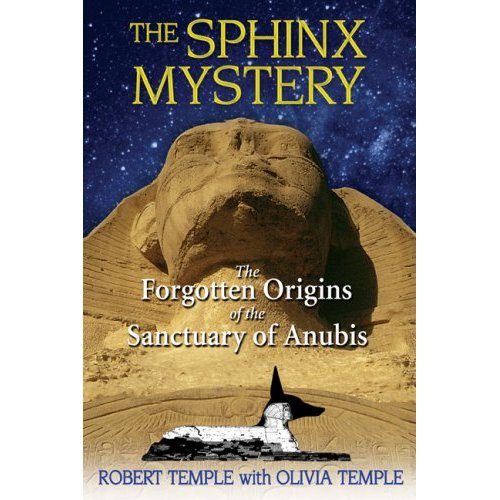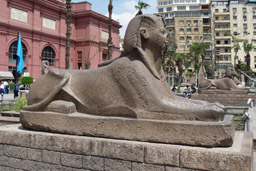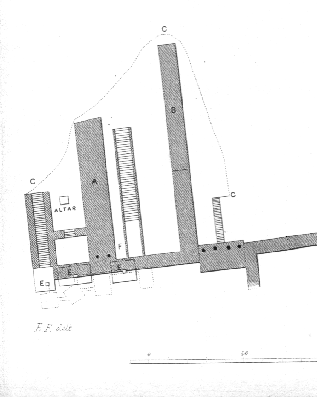| |
![]()
EARTHQUEST
NEWS
Andrew Collins Newsletter Vol. 12 No. 1 (May 2009)
vii.
The Sphinx Mystery by Robert Temple with Olivia Temple
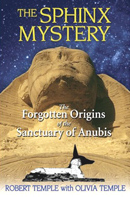 | The most talked about new book at the moment in the subject of ancient mysteries is The Sphinx Mystery by Robert and Olivier Temple (Inner Traditions, 2009). Robert Temple is, of course, the bestselling author of books such as The Sirius Mystery (1976) and The Crystal Sun (2000). Robert and his wife Olivia's subject matter for this new book is the mystery of the Sphinx, and the fruits of their research come highly recommended from a number of different authors in the subject, who each provide testimonials for the cover. |
Among
the many claims made in The Sphinx Mystery is that before the Giza Sphinx
became an andro-sphinx, i.e. a lion with a human head, it was an enormous statue
of the god Anubis in the form of a recumbent jackal, complete with long pointed
ears and extended canine muzzle. It is a subject that Robert Temple first touched
upon in The Sirius Mystery, although here it is a vision outlined in depth.
The authors point out that even by the Pyramid age the god Anubis was seen as
the guardian not just of the entrance to the duat-underworld, whose earthly entrance
was Rostau, the ancient name for Giza, but that the jackal god also guarded the
otherworldly land of the dead, located in the direction of the setting sun. Pyramid
complexes and dynastic cemeteries were invariably situated on the west bank of
the Nile for this very reason, since they functioned as physical representations
of, or at least access points into, the conceived realm of the dead.
The
Temples argue that originally the Sphinx was a carved stone jackal around which
was the sunken enclosure we see today. This they believe functioned as a moat
filled with water channelled from the Nile via a water channel that once existed
between the Valley Temple of Khafre and the enigmatic Sphinx Temple. Further water,
they propose, would have been channelled as run off down a drainage ditch cut
into the bedrock to be seen alongside the northern edge of the stone causeway
that runs past the Sphinx enclosure and links the Second Pyramid with the aforementioned
temples. In this fashion, the limestone bedrock on which Anubis was carved acted
as a primordial mound or island of creation, like the raised areas in the Osireion
at Abydos and the Osiris Shaft at Giza. Moreover, Robert and Olivia Temple point
out that the Sphinx as Anubis is alluded to in the Pyramid Texts, which appear
for the first time c. 2350 BC, as a mythical location called the Jackal Lake,
linked in funerary literature with Rostau, ancient Giza.
Face
of the Sphinx
The authors of The Sphinx Mystery persuasively
argue that the Giza Sphinx remained as a jackal through until the Middle Kingdom
of Egyptian history, which begins c. 1991 BC. They show that the style of its
nemes-headdress only became fashionable in the Middle Kingdom, appearing for the
first time during the reign of the king Amenemhet II, c. 1929-1895 BC, an observation
first made by the German Egyptologist Ludwig Borchardt (1863-1938). Thereafter
carved stone andro-sphinxes were produced in profusion, some of which bear striking
similarities to the face of the Giza Sphinx. More controversially, the Temples
write that in their opinion no sphinxes existed before the Middle Kingdom, a conclusion
compounding their conclusion that our conception of the Giza Sphinx as a lion
is entirely false. The whole world has been duped into believing that the Sphinx
is a lion, when in fact it is the body of a jackal.
In addition to these
theories, Robert and Olivia Temple cite a large number of early references to
the Sphinx, which stem from sources dating from Roman times through until the
first excavations of the Sphinx in the eighteenth and nineteenth centuries. Many
of these sources have not previously been translated, let alone published, and
so the authors must be commended for this workmanship, which is invaluable to
future research on the plateau. These ancient references to the Sphinx the authors
use to demonstrate that a previously overlooked hidden chamber existed within
its back, which has been missed by everyone except for them. I read The Sphinx
Mystery very carefully, making copious notes on all its claims. Its claims
are extraordinary, but in the end I found most if its conclusions wholly untenable.
To explain why will take some time, so bear with me in this comprehensive review.
I want to thank both Colin Reader and Nigel Skinner-Simpson for their invaluable
contributions, as well as for checking the accuracy of my text.
Is
the Sphinx a Doggie?
Let me begin by saying that Robert and Olivia
Temple's proposal that the body of the Giza Sphinx was originally Anubis in the
form of a recumbent jackal is extreme to say the least. Repeatedly, The Sphinx
Mystery tells us that we have all been fooled into believing that the monument
bears a resemblance to the body of a lion, simply because someone else told us
so. There is far more evidence, they suggest, to show that the Sphinx's body resembles
the long sleek shape of a recumbent jackal. Indeed, the Temples offer an outline
of Anubis as a recumbent jackal superimposed on the Sphinx monument, and the resulting
overlay is compelling. The authors also show pictures of carved lion statues from
the Old Kingdom period, when the Giza Sphinx is conventionally thought to have
been carved, and these are seen to bear only a passing resemblance to the shape
of the Sphinx's elongated body. Yet various statues and reliefs, such as those
among the collection of the Petrie Museum, London, show that the basic outline
of lions from this period match the general style of the Sphinx's body at Giza.
 | 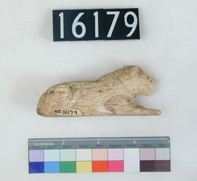 |
Two examples of recumbent lions from the Petrie Museum showing their likeness to the general style of the Giza Sphinx (Pics: UCL/Petrie Museum).
Suggesting that andro-sphinxes never existed in Egypt prior to the Middle Kingdom makes the Temples' theory even more persuasive. However, it is simply not true, as can be seen from an account given by Dr Selim Hassan (1893-1961) in his Excavations at Giza, vol. 8, page 162. Here he says:
. . . in addition to the female Sphinx found at Abu Roash [see below in this review], we have another example from our excavations. While excavating the Mortuary Temple and rock-cut solar boats of Khafra, in the season of 1934-35, I came across a limestone fragment which proved to be of greatest importance for the dating of the early appearance of the Sphinx in Egypt.
This fragment was the base and forelegs of a large limestone Sphinx, the paws being as large as those of a living lion. That it is a true Sphinx and not a lion can be proved by the lower part of the chest which remains on the pedestal, and shows the lower edge of the apron falling forward. In a statue of a lion this junction between the body and the pedestal would be undercut.
From its position near the western solar boat of the King, and the characteristic spacing of the joints of the paws there is no doubt whatever that this fragment relates to a sphinx of King Khafra, and once and for ever removes any doubt as to the existence of the Sphinx in the fourth dynasty.
In addition to this single example of an andro-sphinx, found in connection with Khafre's funerary complex, we know that recumbent lion statues from the Old Kingdom were being being remodelled into andro-sphinxes. A prime example is the one found at Abu Rawash (also spelt Abu Roash), a pyramid field about 4 miles (7 kms) north of Giza. Here once existed a pyramid structure built for the pharaoh Djedefre, a son of Khufu, who ruled c. 2573-2550 BC, immediately prior to Khafre, the builder of Giza's Second Pyramid. A French-Swiss team headed by Emile Chassinat (1868-1948) unearthed a limestone sphinx sporting a nemes-headdress and seemingly female face. Controversy surrounds its age, with most Egyptologists willing to accept that it dates from the Old Kingdom period. Some believe that the statue is contemporary to Djedefre's reign, and actually shows the head of his wife Hetepheres II.

Views of the Sphinx from the north and south respectively, taken in April 2009 by Andrew Collins.
This, however, is mere speculation, as is its age. Some Egyptologists propose that it is the oldest known representation of an andro-sphinx, and might even have inspired the Giza Sphinx. This, of course, is generally thought to have been carved by Khafre, Djedefre's younger brother (from who's funerary complex came the sphinx found by Selim Hassan in 1934-35), or by Djedefre himself, as part of a king's commitment to complete his father's funerary complex upon his death (cartouches bearing Djedefre's name have been found in Khufu's excavated boat pit at Giza). Certainly, there is some resemblance between the body of the Abu Rawash sphinx and its colossal counterpart at Giza.
| Colin Reader, a British geologist who has made a study of the Abu Rawash sphinx, has discovered that originally it was carved in stone with the head of a lion before being altered to produce the surviving andro-sphinx. This was achieved by the addition of a human head rendered in plaster over the original head, with some further modification to the front paws. What is interesting is that some of the plaster has since disappeared to reveal what would appear to be the original feline ears, still in place. |
Abu Rawash sphinx, dating most probably from the Old Kingdom period. |
What
this means is that at some stage in dynastic history, arguably by the end of the
Old Kingdom, statues of recumbent lions were being sequestered in order to make
them into andro-sphinxes with the heads of royal figures.
Side view of the Abu Rawash sphinx with the ears of a lion exposed (pic credit: Colin Reader) | Reader argues that since the body of the Giza Sphinx resembles a lion, then arguably its head was also that of a lion which was subsequently re-carved into the image of a pharaoh at a later date. Certainly, the small nature of the Giza Sphinx's head in comparison to its elongated, flat-backed body is indicative of this surmise. This is also what Robert and Olivia Temple argue, although in their opinion the body and original head was that of a jackal. |
Geological Inconsistencies
In Reader's opinion, the idea that the original head of the Giza Sphinx was that of a jackal is inconsistent with the geology of the limestone outcrop from which the Sphinx was carved. In an email to me dated March 26th he wrote:
The limestone that the Sphinx was carved from is very weak in tension, has frequent discontinuities (both sub-vertically and sub-horizontally) and is not at all suitable for cutting to produce long overhanging jaws/muzzles and towering slender ears. Basically, if you tried to carve the proposed Anubis from the limestones at Giza - the face will most likely have fallen off along a near-vertical fracture in the limestone (similar to the main fissure that cuts through the rear of the Sphinx) before the project could be completed. I accept that similar issues may have been associated with construction of a lion's face but they will have been much, much less of a constraint.
Reader points out also that the Sphinx's body does indeed conform with recumbent lion statues from the Predynastic period, c. 3500-3200 BC, right through until the Old Kingdom period, c. 2700-2137 BC. Moreover, he suggests that lions featured in religious beliefs associated with Khufu, the builder of the Great Pyramid. For instance, as recently as 2001 a Japanese team working at Saqqara unearthed fragments of a ceramic recumbent lion (since restored) among a cache of mostly sixth dynasty objects deposited in a Middle Kingdom tomb.
| It bears Khufu's name inside a cartouche, raising some important issues about the pharaoh's relationship to the lion as a symbol of kingship during the Fourth Dynasty. Certainly, in the first few dynasties of Egyptian history the divine protector of the king was a lioness-headed deity called Bastet (or Bast), who in later times became purely a cat deity worshipped in the Nile Delta. |
Reconstructed ceramanic lion statue found at Saqqara and dated to the Fourth Dynasty. It bears Khufu's cartouche. |
Thus extending this influence to the presence on the plateau at Giza of the Sphinx is not unreasonable, even though Reader is of the opinion that as a recumbent lion it belongs to an age earlier than Khufu and his contemporaries, most probably the Early Dynastic period, c. 3100-2700 BC (1).
The
Tomb Chapel of Khufu-khaf
The Temples' best evidence for the Giza Sphinx
being a representation of Anubis are what he describes as "super-sized"
reliefs of the god as a recumbent jackal seen in Fourth Dynasty tomb chapels at
Giza, the most blatant being that of Khufu-khaf I (also written Khaf-Khufu I),
a son of Khufu, found in a mastaba tomb (# 7140) located in the pyramid field's
eastern cemetery. Here two such reliefs form part of a standard offering formula
inscribed on the walls of funerary chapels and asking for a safe passage into
the afterlife for the deceased. This is done in the name of Anubis in his role
as "foremost of the necropolis", that is as the guardian of the entrance
in the west to the land of the dead. The images are huge in comparison to the
hieroglyphs around them, and in the tomb of Khufu-khaf super-sized Anubis reliefs
appear both on the north wall and south wall of the east-west orientated entrance
corridor. They are the first images seen on entering the tomb, and both examples
face east, as if guarding the western entrance to the land of the dead. Their
orientation mimics that of the Giza Sphinx, located in a dip around 300 meters
to the south of Khufu-khaf's tomb chapel. Both examples, as well as another super-sized
Anubis in another Fourth Dynasty tomb chapel at Giza referred to by Robert and
Olivia Temple, sport nemes-headresses, something usually only reserved for anthropomorphic
representations of Anubis. Each animal also has a long slim body, with an extended
tail that drops vertically towards the floor.
The presence of these super-sized
Anubises in tomb chapels belonging to Egypt's Fourth Dynasty has allowed the authors
of The Sphinx Mystery to conclude that the Sphinx also was a form of Anubis,
guarding the western entrance to the land of the dead - its sleek body matching
those of the contemporary reliefs. This is a bold and compelling theory. However,
the main drawback in its acceptance is the artistic style of the Sphinx monument.
Even though it does possess a long slim body, its tail curls around the right
side of the rump, across the base of the right hind leg, before rising up to finish
on the beast's hindquarters. This is a style characteristic of lion statues from
Predynastic times onwards, including the examples cited above from Abu Rawash
and Saqqara.
Two examples of Anubis hieroglyphs from Old Kingdom tombs on the plateau at Giza (pic credits: Andrew Collins). | In contrast, Anubis as a jackal, is invariably shown with its tail out straight, before immediately turning downwards at an angle. I photographed as many images of Anubis as a jackal that I could find with the Giza necropolis in April 2009, and could not locate any that showed the animal's tail curled up over its hindquarters, like that of the Sphinx monument. |
I
also examined all Anubis statues in the Egyptian museum, Cairo, looking for statues
with curved tails over the hindquarters, the usual manner of design was to manufacture
them with straight, detachable tails that drop vertically (the statues were meant
originally to stand on small bench-like shrines, as in the much larger example
famously found in Tutankhamun's tomb). Many of these tails, as well as their box
shrines, are now missing from surviving statues, leaving only a square hole where
the tail had once been attached to the body.
| I did eventually find in the Egyptian Museum a single bronze statue of Anubis with an upcurling lion's tail. It bore no description, yet from the style, which by its realistic features, as opposed to the conventional style of Anubis statues, which possess unnaturally extended muzzles, I would say that the small bronze dated to the Graeco-Roman period. Thus I suspect that this style of design was only adopted in Egypt at this time. Connected perhaps is the fact that modern tourist statues of Anubis often have an upcurling lion's tail, an artistic feature employed in order to make the mass casting of statues possible. Thus there is very little contemporary evidence to compare Anubis's conventional art style with the structural design of the Giza Sphinx, which in my opinion began its life as a lion before being altered into an andro-sphinx. |
The supersized Anubis relief on the north wall of the entrance passage to the tomb chapel of Khufu-khaf I, a son of Khufu. Note its elongated muzzle and nemes headdress. Pic credit: Andrew Collins/Rodney Hale. |
The most curious fact about the carved Anubis relief on the north wall of the entrance to Khufu-khaf's tomb chapel is that its muzzle is far too long and slim to be that of a normal jackal. The fact that its ears are also now simply stumps, most obviously through degradation of the relief, makes its appearance, complete with nemes-headdress, that much stranger.
Pic credit: Andrew Collins/Rodney Hale If the Sphinx was a form of Anubis, then the presence of supersized reliefs of the god in canine form within the tomb of Khufu-khaf I (G7140), inside his tomb chapel in Giza's eastern cemetery, should support the contention that they are representations of the imposing monument just 300 meters to the south. Indeed, the reliefs, according to Robert and Olivia Temple in The Sphinx Mystery, were most likely inspired by the nearby presence of the Sphinx, or perhaps vice versa. So British engineer Rodney Hale overlaid an image of Anubis as the jackal to see whether this surmize might be correct. Yet the resulting overlay shows clearly that if the Sphinx had been a canine then it was certainly not inspired by contemporary Old Kingdom depictions of Anubis in the form of a recumbent jackal. The head of the Sphinx is too large to fit that of the jackal. Decreasing the size of the Sphinx's head to fit the match better would severely shorten, pro-rata, the length of the monument against that of the jackal.
Pics credit: Andrew Collins/Rodney Hale When
you compare the Sphinx profile against the super-sized Anubis relief on the south
side of the entrance passage into the tomb chapel of Khufu-khaf we can see that
for the Sphinx head to have been recarved from a jackal's head, with a suitable
pro-rata body, it would mean that the jackal's head and back would have far exceeded
the size of the monument. Deceasing the size of the jackal would have meant the
jackal's body being far out of proportion to the Sphinx's body. Pics:
|
Obscure
Origins of the Sphinx
One of the reasons why Robert and Olivia Temple
are able, quite easily, to propose that the Sphinx was originally a jackal, and
not a lion, is that there are no obvious mentions of the monument in any inscription,
either on the plateau, or elsewhere, until the commencement of the New Kingdom,
c. 1575 BC. How could such a magnificent structure have gone unmentioned for at
least a thousand years, if not longer? It just doesn't make good sense. The most
likely answer is that it is mentioned, although not in any obviously recognizable
form, cue the Temples' proposal that it is mentioned, but only in its guise as
Anubis. Other writers, including Robert Bauval and myself, have argued that the
Sphinx is mentioned in ancient Egyptian texts under the name Horakhty, a form
of the hawk or hawk-headed god signifying the sun on the horizon. Significantly,
British Egyptologist Richard Wilkinson has pointed out that Horakhty could take
the form of a cosmic lion. This makes sense since as early as the reign of the
New Kingdom king Amenhotep I, c. 1525 BC, the Sphinx was addressed as Re-horakhty,
the sun as Horakhty, as well as Horemakhet, a name for Horus as the sun on the
horizon applied specifically to the Giza monument. Horakhty was also associated
with the Heliopolitan creator god Atum as Re-horakhty-atum, another name to which
the Giza Sphinx was addressed during the New Kingdom period.
The body of
the Sphinx may not have been visible during the reign of Amenhotep I, since the
so-called Dream Stela, erected between the paws of the Sphinx during the reign
of Thutmosis IV, c. 1413-1405 BC, suggests that sand had covered the monument
until this time. If this is correct (and my colleague Chris Ogilvie Herald argues
against the Sphinx enclosure being engulfed with sand until very late on in dynastic
times), then the only thing that can have led to the Sphinx being identified with
Re-horakhty, which could take the form of a cosmic lion, as early as the reign
of Amenhotep I is that there was an existing tradition linking the monument with
a god in the form of a lion. Adding to the mystery is that during the New Kingdom
period the Sphinx was being addressed in inscriptions as Hauron (also written
Horon, Chauron or Hwron), the name of a chthonic or underworld deity of Syro-Canaanite
origin. Dr Selim Hassan, the Director of Excavations on behalf of the American
University in Cairo, who excavated the Sphinx area 1936-37 and continued his work
in the rock-cut tombs in the enclosure walls in 1937-38, wrote that the name Hauron
was the origin of the monument's Arab name of Abou-l Hwl, "Father of Terror".
The word hwl is merely a corruption of Hwron, which itself derives from the Semitic
root hor meaning the bottom of a well, or "hole". The abou element Hassan
saw as a corruption of the ancient Egyptian bw, meaning "place", suggesting
bw-hwron, the "place of the god Hauron".
Canaanite inscriptions
mention Hauron being sent into the "chamber of darkness", a form of
underworld, to sort out demons, including wolves, encroaching on this world. More
significantly, Hauron was envisioned as a form of winged lion, or cherubim, the
reason why New Kingdom reliefs of the Giza Sphinx occasionally show its body covered
in feathers. Thus it seems certain that Syrian and Canaanite settlers, most obviously
during the Hyksos period, c. 1625-1575 BC, came to Giza and identified the Sphinx
with their own winged lion Hauron, a connection that not only stuck but was acknowledged
in numerous royal inscriptions from the New Kingdom period.
Further east,
among the civilizations of the Fertile Crescent, Hauron was identified with a
deity called Nimru, which means "panther". In Akkado-Sumerian texts
Nimru
was identified with a sky-figure in the form of a panther-griffin (i.e.
half feline/half eagle) called UD.KA.DUH.A, made up of stars from the constellations
of Cygnus and Cepheus.
So we can see that from the New Kingdom onwards
the Giza Sphinx was seen as the personification of feline god forms both of Egyptian
and Canaanite origin. Surely, if the monument had started its existence as a canine,
then some semblance of this cult would have lingered at Giza, and found its way
into inscriptions at the commencement of the New Kingdom. Yet this was simply
not the case. All the indications are that the Sphinx at Giza was generally identified
as a lion, even at times when only its head would have been visible above the
desert sands.
Whose
Face is it Anyway?
The authors of The Sphinx Mystery go against
the idea that the face of the Sphinx is that of Khafre, the builder of the Second
Pyramid, its usual designated identity according to Egyptologists, through the
most flimsiest evidence (contextual relationship to the Second Pyramid and its
funerary complex, and the first syllable of the name Khafre found in a damaged
line at the base of the Dream Stela). The Temples also go against more recent
proposals by Egyptologists such as Rainer Stadelman and Vassel Dobrev, suggesting
that the Sphinx was carved during the reign of either Khufu or his son Djedefre.
To Robert and Olivia Temple the face of the Sphinx is that of the Middle Kingdom
pharaoh Amenemhet II, who reigned c. 1929-1895 BC. He came across the exposed
head of the now damaged jackal, remodelled it in the image of himself, and cleared
away the sand that clogged its body.
The Temples cite the artistic style of the stripes on the interior of the monument's nemes-headdress as evidence of its re-carving at this time, since it is a style not thought to have existed prior to this time. Afterwards, stone andro-sphinxes both large and small were created for the very first time, perhaps in celebration of the re-carving of the Giza Sphinx in Amenemhet II's image. Later pharaohs created their own image on sphinxes, a tradition that continued throughout dynastic history.The problem with this theory is that if andro-sphinxes only began appearing after this time, then why, if the animal in question was a jackal, are the recumbent sphinxes of the Middle Kingdom clearly lions with human heads? |
Granite sphinxes on front of the Egyptian Museum, Cairo (pic credit; Andrew Collins) |
The Temples would argue, presumably, that they are still dogs, or that the Sphinx was now considered a lion, but such ideas seem nonsensical, especially since we know that lion statues were being sequestered to be remodelled as andro-sphinxes from the Old Kingdom onwards. On top of this, geologist Colin Reader has uncovered evidence that the artistic style of the stripes on the interior of the Sphinx's nemes-headdress was in use during the reign of Menkaure, the builder of the Third Pyramid, c. 2525 BC. He is writing a paper on this subject, so I will not pre-empt his work in this respect. So although it cannot be ruled out that the Sphinx's familiar head was not carved in the Middle Kingdom, it is more likely older than this time.
Anubis
as Guardian of Rostau
Giza's ancient name was Rostau (also translated
as Re-stew or Rose-tau), which means the "mouth of the passages", a
reference to the entrance to the underworld realm known as the duat in ancient
Egyptian literature. Robert and Olivia Temple state that Anubis guarded the western
entrance to the land of the dead, synonymous also with the concept of the duat-underworld.
As such Anubis was the obvious choice as a guardian for the Giza plateau, long
seen as a physical representation of the duat-underworld, and an entrance to the
westerly placed land of the dead. This seems confirmed by the fact that Anubis
is alluded to in connection with Rostau in both the Pyramid Texts, which date
to c. 2350 BC.
However, as the Temples admit themselves, the same role
of guardian to the duat-underworld was held by a lion (ru), or double lion
(ruti), called also the Aker (or Akeru in plural), a form
of earth-god. Many writers have identified the Sphinx as one of the two lions
guarding the double horizon in ancient Egyptian myth and legend. It therefore
seems likely that in addition to being identified with lion deities such as Horakhty,
Hor-em-akhet and Hauron, the Great Sphinx was seen also as one of the Aker, or
Ruti, lions which stood at the entrance and exit to the underworld. Indeed, this
seems, as we saw above, to have been the role of the god Hauron in Syro-Canaanite
tradition.
Lastly, if the Sphinx had been a jackal deity, then there should
be evidence of votive offerings to a dog deity found at Giza, when clearly there
are none. Plus there is no surviving folklore suggesting that it was ever a dog
or jackal, nothing.
Sphinx
Enclosure as a Moat
Robert and Olivia Temple's proposal that the Sphinx
enclosure was once a moat filled with water, which acted as a symbolic island
of creation, is a fascinating idea. This said, it is lacking in any corroborative
evidence. Firstly, Dr Selim Hassan excavated the Sphinx enclosure down to the
bedrock and found no obvious evidence of sedimentary deposits, created either
by decaying organic life or alluvial sludge, which will have accumulated if the
Sphinx enclosure had been filled with water during Old Kingdom times.
Secondly,
as has been pointed out to me by geologist Colin Reader, the bedrock on the east
side of the Sphinx Temple and Valley Temple of Khafre, between which the Temples
propose was a water channel through which Nile water could have passed, is perhaps
as much as 4 meters lower than the base of the Sphinx enclosure. This means that
the water would have needed to be channelled up hill through, presumably, a series
of sluice gates, the existence of which eludes us. Certainly, a quay, probably
served by a canal linked to a tributary of the nearby Nile, was located immediately
east of the Valley Temple, but this was most probably built to enable the pharaoh's
funerary barge to reach its final destination, and to supply building materials,
including Turah limestone and Aswan granite, for use in the construction of Khafre's
funerary complex. There is no evidence that this canal served to supply water
to the Sphinx enclosure.
Beyond this there is no evidence whatsoever regarding
the ritual usage or identity of the Sphinx during the Pyramid age. In addition
to this, the monument is likely to have spent long periods of time up to its neck
in sand, a constant problem that would have dogged any period of dynastic history
after the onset of desiccation leading to the creation of the Libyan desert sometime
during the Pyramid age.
Thirdly, the legs and paws of the Sphinx are carved
out of the very base of the Sphinx enclosure, meaning that if water did fill its
enclosure then these would have been quickly submerged. This seems a peculiar
design feature if the Sphinx was to have acted as the guardian of a primeval island
of creation on which it supposedly rested. Not only would its front legs, paws,
and even parts of the tail, have been invisible underwater, but it does not sit
on an island-like area in the first place. This means that there would not have
been any "Jackal Island", just a half-drowned dog.
Finally, Colin
Reader proposes that the drainage channel which Robert and Olivia Temple suggest
carried additional water into the Sphinx enclosure from higher up the plateau
can only be traced for a distance of around 35 meters. It is cut out of the bedrock
on the north side of the stone causeway linking the Second Pyramid to the Sphinx,
but Reader has been unable to find it goes any further. It does not appear to
be present where a tunnel has been cut through the causeway higher up the plateau
(the one which leads to the entrance of the so-called Osiris shaft).
The
Chamber That Never Was
Another massive claim by the authors of The
Sphinx Mystery is that present within the back of the Giza Sphinx is a secret
or "hidden" chamber, explored for the first time in 1817 by the redoubtable
Italian explorer and former sea-captain Giovanni Battista Caviglia (1770-1845),
the first person to properly clear away the sand that had engulfed the monument
since Roman times. Robert Temple suggests that this chamber was subsequently hushed
up by the Italian, since it was never again picked up on either by Egyptologists
or revisionist writers, until he and his wife realized its existence and huge
significance. In this respect, the Temples ask "... how do we know that Caviglia
really entered the chamber beneath the Sphinx". The Sphinx chamber alluded
to here is one said to exist at the bottom of a vertical shaft, which was entered
from on top of the Sphinx near the hindquarters.
In answer to the question
posed, the Temples cite a story dating from 1855 attributed to the French Egyptologist
Auguste Mariette (1821-1881), and reported in a French periodical at the time,
which speaks of the discovery of a plan of two chambers found "behind"
the Sphinx in Caviglia's papers. The chambers, it says, were purported to contain
hieroglyphic texts. The article also mentions the British explorer Samuel Birch
(1813-1885), an Egyptologist working with the British Museum, who had the thought
that if the chambers could be rediscovered the inscriptions might throw light
on the origins of the Sphinx. It also says that Mariette was of the opinion that
the vertical shaft accessed via the back of the Sphinx, at the bottom of which
was a roughly hewn room, was in actuality a natural fissure reshaped by man (and
visible until finally filled in with concrete by the French Egyptologist Émile
Baraize after he began excavating the Sphinx and its enclosure in 1926).
With
all this in mind the Temples state, in connection with the above article, that
"Caviglia is said to have done plans of two chambers beneath (i.e. inside)
the Sphinx and we must suppose that the second one was the hollow at the bottom
of the rump tunnel, since Mariette speaks of only one chamber at the bottom of
the vertical shaft." From this they conclude that since there are no hieroglyphic
inscriptions in the small, hollowed-out tunnel accessed via the Sphinx's rump,
then they must have been inscribed on the walls of the chamber at the bottom of
the aforementioned vertical shaft in the Sphinx's back. Initially, this might
seem a logical conclusion, which if correct would mean that a "hidden chamber"
in the Sphinx's back contained hieroglyphic inscriptions, a revelation that might
indeed have thrown light not just on the monument's former identity, but also
any religious practices that might have gone on in its dark depths. Backing up
the significance of this previous unknown chamber is the fact that the Temples
cite the fact that Mariette found at its base certain fragments of wood, which
might easily have belonged to a coffin from a burial.
There is a huge problem,
however, in accepting any of this as fact. Firstly, the shaft in the back of the
Sphinx was, as Mariette noted himself, simply a natural fissure widened at its
base by human hands (and possibly used to contain a burial). More crucially, the
idea that this compartment was a "hidden chamber" secretly entered by
Caviglia in 1817 who found here hieroglyphic inscriptions, and later hushed up
the whole episode as part of some kind of archaeological conspiracy is simply
pie in the sky.
Let me explain, courtesy of some diligent research by my friend
and colleague Nigel Skinner-Simpson, an independent researcher of Egyptology who
specializes in past and present excavations at Giza. The aforementioned French
article quoted by the Temples in The Sphinx Mystery makes reference to
chambers "behind" the Sphinx, yet on page 98 of their book "behind"
becomes "beneath". So was the chamber containing hieroglyphs "behind"
the carved monument, or "beneath" it, i.e. inside it? There is one hell
of a difference here, leading to enormous possibilities of ambiguity.
The
answer lies in an article not quoted by the authors of The Sphinx Mystery.
It was penned by Samuel Birch - the same Birch mentioned in Temple's quoted article
- and is entitled "Excavations Around The Sphinx". It is found in The
Museum Of Classical Antiquities (vol. 2), a short-lived quarterly journal published
between 1851 and 1853. The main illustration accompanying the paper is entitled
"Plan of Discoveries By Captn. Caviglia, Behind And In The Neighbourhood
Of The Great Sphinx", and shows: "Wells or Shafts descending from three
upper chambers to five lower chambers" - these shafts and other features
being located in the enclosure wall north-west of the rear of the Sphinx. Birch
says in connection with these subterranean shafts that "Their object (i.e.
purpose), indeed, is unintelligible without the inscriptions which were found
in them" by Captn. Caviglia, showing that they are the same ones alluded
to by Birch in the French article quoted by the authors of The Sphinx Mystery,
which was published just two years later in 1855. Thus it would appear that the
chambers containing the hieroglyphs alluded to in the French article were located
within shafts behind the Sphinx, and not beneath it. So there was no hidden chamber
entered by Caviglia inside the Sphinx, no hieroglyphic inscriptions within it,
no deliberate concealment of the same and, finally, no connection with the Frenchman
Baraize filling in the natural fissure and hollowed out area in the back of the
Sphinx during the 1920s. Sorry, but these are the facts - not the fact that everyone,
except for the Temples, has overlooked the existence of a hitherto unknown secret
chamber in the Sphinx.
"Plan of Discoveries By Captn. Caviglia, Behind And In The Neighbourhood Of The Great Sphinx" from the article dated 1851-53 by Samual Birch (pic credit: Nigel Skinner Simpson). |
Close up of the shafts and chambers investigated by Caviglia in 1817, and containing the hieroglyphs alluded to in the French article of 1855, as quoted by the authors of The Sphinx Mystery (pic credit: Nigel Skinner Simpson). |
Despite the many reservations I have about the nature of the theories proposed in The Sphinx Mystery, I would still recommend it, not only for it bold attempts to change the face of alternative research at Giza, but also for the numerous, previously unknown accounts of the Sphinx from Roman times through to the present day.
Notes:
1. Reader, Colin, "Giza Before the Fourth Dynasty", Journal of the Ancient
Chronology Forum (JACF) 9 (2002), pp. 5-21.
![]()
| |
